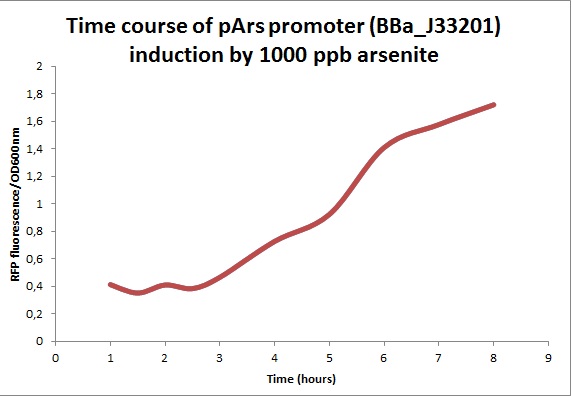Team:Buenos Aires/ model
From 2013.igem.org
(→Deterministic Model) |
(→Deterministic Model) |
||
| Line 9: | Line 9: | ||
More specifically, the idea was to produce different amounts of a coloured pigment depending on the concentration of the contaminant present in water. | More specifically, the idea was to produce different amounts of a coloured pigment depending on the concentration of the contaminant present in water. | ||
| - | We worked with Arsenic knowing that an Ars operon exist in nature and more important, it exists as biobricks. | + | We worked with Arsenic knowing that an arsenic detoxification operon (Ars operon) exist in nature and more important, it exists as biobricks. |
| Line 15: | Line 15: | ||
For our biosensor we came up with three different designs each one motivated on improving the flaws detected while analysing the previous ones using mathematical models as our main tools. | For our biosensor we came up with three different designs each one motivated on improving the flaws detected while analysing the previous ones using mathematical models as our main tools. | ||
| - | + | We describe briefly the first two designs which were later rejected to emphasize the importance of mathematical model to gain insight on how our system works and as a feasibility study. | |
| - | + | ====Arsenic promoter + ArsR + RFP==== | |
Revision as of 00:07, 25 September 2013
Contents |
Deterministic Model
Introduction
Our objective was to assemble a system that could respond to different concentrations of a specific contaminant in water. More specifically, the idea was to produce different amounts of a coloured pigment depending on the concentration of the contaminant present in water.
We worked with Arsenic knowing that an arsenic detoxification operon (Ars operon) exist in nature and more important, it exists as biobricks.
Got Ideas?
For our biosensor we came up with three different designs each one motivated on improving the flaws detected while analysing the previous ones using mathematical models as our main tools. We describe briefly the first two designs which were later rejected to emphasize the importance of mathematical model to gain insight on how our system works and as a feasibility study.
Arsenic promoter + ArsR + RFP
Unfortunately
As it is shown in the figure below, in the presence of arsenite (1000 ppb) a typical transcriptional induction is observed over time. There is a lag of 3 hours in the mRFP produciton after adding arsenite.
 "
"
